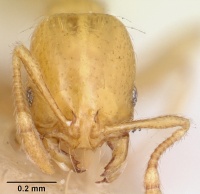Solenopsis lucayensis
| Solenopsis lucayensis | |
|---|---|

| |
| Scientific classification | |
| Kingdom: | Animalia |
| Phylum: | Arthropoda |
| Class: | Insecta |
| Order: | Hymenoptera |
| Family: | Formicidae |
| Subfamily: | Myrmicinae |
| Tribe: | Solenopsidini |
| Genus: | Solenopsis |
| Species complex: | globularia |
| Species: | S. lucayensis |
| Binomial name | |
| Solenopsis lucayensis Wheeler, W.M., 1908 | |
Nothing is known about the biology of Solenopsis lucayensis.
Identification
A New World thief ant that is a member of the globularia species complex
Pacheco and Mackay (2013) – Worker - The worker is easily recognized by the large dilated postpetiole. It is distinguished from other members of the globularia complex by being concolorous pale yellow, with an eye of 12-15 ommatidia and appears to be monomorphic based on the material available.
Solenopsis lucayensis is recognized as a valid species. Further collection in the Bahamas or molecular analyses may show this to be a synonym (a color variant) of Solenopsis globularia, however based on the material examined, it appears to be monomorphic, consistently concolorous pale yellow, with workers that have 12-15 ommatidia for the eye; not 18-22 as seen with other forms of the globularia species complex. The mesopleuron and metapleuron are horizontally striated. Although the striae on the propodeum seem to be variable within this complex, it is consistently not visible on the dorsal portion of the side of the propodeum.
Keys
- Key to New World Solenopsis Species Complexes
- Key to workers of the globularia species complex / Clave para las obreras del complejo globularia
Keys including this Species
Distribution
Distribution based on Regional Taxon Lists
Neotropical Region: Bahamas (type locality).
Distribution based on AntMaps
Distribution based on AntWeb specimens
Check data from AntWeb
Countries Occupied
| Number of countries occupied by this species based on AntWiki Regional Taxon Lists. In general, fewer countries occupied indicates a narrower range, while more countries indicates a more widespread species. |

|
Estimated Abundance
| Relative abundance based on number of AntMaps records per species (this species within the purple bar). Fewer records (to the left) indicates a less abundant/encountered species while more records (to the right) indicates more abundant/encountered species. |

|
Biology
Castes
Known only from the worker caste.
Worker
Images from AntWeb
 
| |
| Cotype of Solenopsis lucayensis. Worker. Specimen code casent0103219. Photographer April Nobile, uploaded by California Academy of Sciences. | Owned by MCZ, Cambridge, MA, USA. |
Nomenclature
The following information is derived from Barry Bolton's Online Catalogue of the Ants of the World.
- lucayensis. Solenopsis globularia subsp. lucayensis Wheeler, W.M. 1908a: 131, pl. 11, fig. 8 (w.) BAHAMAS (Andros I.).
- Type-material: lectotype worker (by designation of Pacheco & Mackay, 2013: 213),14 paralectotype workers.
- Type-locality: lectotype Bahamas: Andros I., Nicholl’s Town, 14.v.1904 (W.M. Wheeler); paralectotypes with same data.
- [Note: this taxon is based on specimens originally identified as S. globularia (F. Smith) by Wheeler, W.M. 1905b: 89.]
- Type-depository: MCZC.
- Subspecies of globularia: Forel, 1912g: 4; Emery, 1922e: 199; Creighton, 1930b: 112; Ettershank, 1966: 142; Kempf, 1972a: 236; Bolton, 1995b: 389.
- Status as species: Pacheco & Mackay, 2013: 212 (redescription).
- Distribution: Bahamas.
Unless otherwise noted the text for the remainder of this section is reported from the publication that includes the original description.
Description
Worker
Pacheco and Mackay (2013) - Measurements (n=5). TL 1.80-2.04 (1.90); HL 0.510-0.528 (0.513); HW 0.420; EL 0.072-0.078 (0.077); ED 0.054; SL 0.360; FSL 0.162-0.168 (0.166); CI 79.5-82.4 (81.8); SI 68.2-70.6 (70.1); PL 0.090; PW 0.150-0.162 (0.157); PI 55.6-60.0 (57.3); PPL 0.180; PPW 0.240-0.252 (0.242); PPI 71.4-75.0 (74.3); WL 0.360; PSL 0.030; PSW 0.030.
Moderately large; monomorphic; concolorous pale yellow; head subquadrate, sides convex, finely punctate; five lateral teeth present, angulate, including medial tooth; clypeal carinae well defined; scape reaches ¾ length of head; minor funicular segments 3-8 long (average 0.166 mm); eye large, 12-15 ommatidia; pronotum smooth and shiny; mesopleuron horizontally striated; notopropodeal suture well depressed; posterior edge of propodeum angulate; propodeal spiracle small, round; metapleuron horizontally striated; peduncle long at 0.720 mm; petiole smaller than postpetiole viewed laterally and dorsally, peduncle lacking tooth or flange ventrally; postpetiolar node greatly dilated, globose, postpetio1e lacking tooth or flange ventrally.
Abundantly hairy, pilosity pale yellow; erect hairs of various lengths (0.030-0.120 mm) on dorsum of head; erect and sub erect hairs of various lengths (0.036-0.150 mm) on dorsum of mesosoma, pointing in different directions.
Type Material
Bahamas Andros Island, May-June 1904, W. M. Wheeler ColI., M.C.Z. Cotype 1-15 20926 (lectotype worker [here designated] and 14 paralectotype workers Museum of Comparative Zoology).
References
- Pacheco, J.A. & Mackay, W.P. 2013. The systematics and biology of the New World thief ants of the genus Solenopsis (Hymenoptera: Formicidae). Edwin Mellen Press, Lewiston, New York. 501 pp.
- Wheeler, W. M. 1908a. The ants of Porto Rico and the Virgin Islands. Bull. Am. Mus. Nat. Hist. 24: 117-158 (page 131, pl. 11, fig. 8 worker described)
References based on Global Ant Biodiversity Informatics
- Creighton W. S. 1930. The New World species of the genus Solenopsis (Hymenop. Formicidae). Proceedings of the American Academy of Arts and Sciences 66: 39-151.
- Ettershank G. 1966. A generic revision of the world Myrmicinae related to Solenopsis and Pheidologeton (Hymenoptera: Formicidae). Aust. J. Zool. 14: 73-171.
- Fernández, F. and S. Sendoya. 2004. Lista de las hormigas neotropicales. Biota Colombiana Volume 5, Number 1.
- Kempf, W.W. 1972. Catalago abreviado das formigas da regiao Neotropical (Hym. Formicidae) Studia Entomologica 15(1-4).
- Morrison L. W. 1998. A review of Bahamian ant (Hymenoptera: Formicidae) biogeography. Journal of Biogeography 25: 561-571.
- Pacheco J. A., and W. P. Mackay. 2013. The systematics and biology of the New World thief ants of the genus Solenopsis (Hymenoptera: Formicidae). Lewiston, New York: Edwin Mellen Press, 501 pp.
